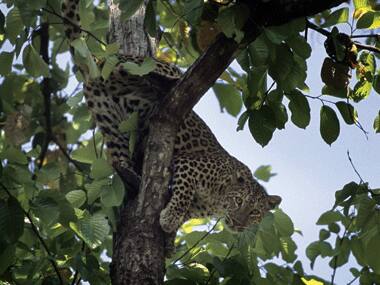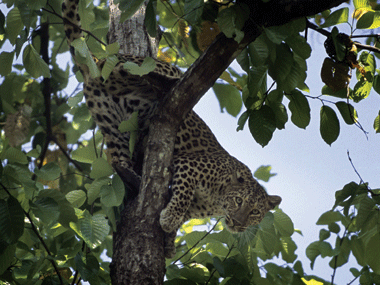A recent paper, Big Cats in Our Backyards, published by the journal Public Library of Science has made headlines by reporting up to six resident leopards per 100 sq km in Maharashtra’s Sangamner region. The big cats hide in the dense cover of sugarcane fields during the day and prey on village (and town) dogs in the night. No significant man-animal conflict has been reported in the study area. This is a great find in a country where leopards are frequently persecuted as blood-thirsty animals by lynch mobs and trigger- or trap-happy officials. This unwarranted hostility is also the reason why leopards kill so many people. Few of us expect a wild animal, particularly a carnivore, to show up outside forests. People panic at the sight of leopards near habitations and try to kill or catch and release animals in faraway forests. But the leopard’s preference for smaller domestic prey often makes it a resident of fringe forests close to villages or, as the recent study has established, even cropland bereft of any wilderness. If trapped and removed, they try to return home. In the process, traumatised cats walk long distances, run into people, causing injuries and deaths. The sugarcane leopards reported by the study are thriving in a densely populated agricultural landscape because people here apparently do not mind their presence. Why this particular community is more tolerant or confident than most others across the country is not explained in the study but its non-interfering conduct has succeeded in avoiding serious conflict. The lesson is that leopards, unless disturbed, rarely pose a threat to human safety. Like all species, leopards need food and shelter. Most human habitats are packed with smaller livestock and dogs and offer more resources than many prey- and water-deficient protected forest areas (PAs). So be it the sugarcane fields of Maharashtra or the city forests of Shimla, the availability of good cover for safety is the deciding factor for the presence of leopards. These populations cannot be wished away by killing or by shifting a few cats which aggravates, even creates, conflict. [caption id=“attachment_679496” align=“alignleft” width=“380”]  Image courtesy: Dhritiman Mukherjee.[/caption] Of course, local extermination is possible through rapid and consistent mass killing but the strategy is neither legal nor sanctioned by our conservation policies. Poaching apart, the only other way a non-PA population can eventually disappear, over a period of high conflict, is through loss or destruction of functional cover. This fact questions the study’s first unsupported claim that the tolerance of the people is the prime reason for the high density of leopards in sugarcane fields. The choice of the study site itself is perhaps responsible for the unusual numbers. Leopards live outside protected forest areas (PAs) in most parts of India. Going by media reports from across the country, chance encounters with people rarely occur during the night when leopards are active, scouting the villages and towns for food. It is mostly during the day that the leopard’s cover is blown, setting a lynch mob after it. This indicates a lack of cover that is so essential for the cat to stay safe during its passive day hours. Sugarcane plants offer dense cover and the crop is harvested in batches at long intervals, ensuring months of uninterrupted privacy. Once there is reliable data on the frequency of human-leopard encounters in sugarcane fields, a comparative study in a non-sugarcane cropland may explain how a reduction in cover affects the intensity of conflict – and the density of leopards – outside protected forests. So should we focus on non-PA areas, as the study demands, as a policy shift from our PA-centric conservation model? Yes and no. We certainly need to invest in unprotected fringe forests. But cropland, particularly the sugarcane fields highlighted in the study as suitable leopard habitat, is beyond the scope of large carnivore conservation. Leopards get to use patches of fringe, non-protected forests in many areas because some social input – community tradition, administrative effort or civic activism – has secured those stretches against the axe. On the other hand, conservationists get to make a stronger case for the survival of these non-PA forest patches in the name of protecting the resident leopards. That is how different goals of conservation – species recovery and ecosystem integrity – overlap. Things get tricky in a modified cropland such as sugarcane fields. The selection of the sugarcane crop was a purely economic decision and not to help the leopard. Similarly, if the obscenely water-intensive crop fails or is withdrawn from a drought-affected Maharashtra in the near future, concerns for leopards will not, and should not, weigh in. In such a scenario, these leopards will be flushed out as rapidly as they had moved in when irrigation was introduced here two-and-a-half decades ago. Till that time, these resource- and cover-rich sugarcane areas are likely to draw carnivores to its capacity from the adjoining prey- and water-deficient forests. Over time, this may cause the bulk of the leopard population of the region to gravitate towards the sugarcane fields and get accustomed to easy domestic prey. Since the future of the sugarcane crop is not determined by any conservation input, a change in crop selection or land use may suddenly expose a large number of leopards, triggering major conflict. Meanwhile, we do not need to reinvent the wheel. Over centuries, leopards have adapted to survive next to people without major conflict. The near foolproof cover of sugarcane fields only makes their job easy. While that cosy arrangement may not last too long, elsewhere they are already running for cover. So the next time you happen to spot a leopard, tell yourself it means no harm. Just that the poor cat does not have a sugarcane field to hide in.
Till the water flows in the irrigation canals, these cats will make happy headlines. Then they will be as doomed as any other leopard unless we learn to hold our nerve.
Advertisement
End of Article
Written by Jay Mazoomdaar
Recipient of a number of journalism awards and prizes, including those from International Press Institute, Commonwealth Press Union and Prem Bhatia Trust, for his investigative reports, Jay Mazoomdaar’s focus is on environment, development, community and conflict. An independent journalist based in Delhi, he also dabbles in political and sports writing and films occasional documentaries. see more


)
)
)
)
)
)
)
)
)



